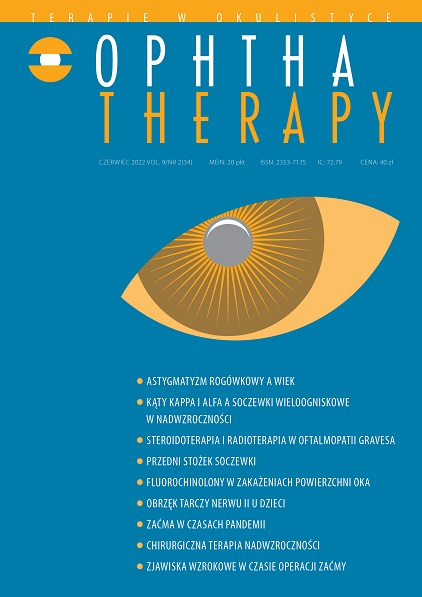Zmiana astygmatyzmu rogówkowego wraz z wiekiem Artykuł przeglądowy
##plugins.themes.bootstrap3.article.main##
Abstrakt
Praca ma charakter teoretyczny i powstała w celu sprawdzenia związku między zmianami astygmatyzmu a wiekiem. Analiza została przeprowadzona na podstawie dostępnych badań opisanych w literaturze przedmiotu. Zebrane dane statystyczne i informacje medyczne pozwalają na sformułowanie wniosku, że astygmatyzm może ulegać zmianie wraz z wiekiem. Zrealizowany projekt przedstawia wyniki, które posiadają zarówno wartość poznawczą, jak i aplikacyjną. Stwierdzone powiązania mogą być wykorzystane w praktyce lekarskiej pacjentów z niezbornością.
Pobrania
##plugins.themes.bootstrap3.article.details##

Utwór dostępny jest na licencji Creative Commons Uznanie autorstwa – Użycie niekomercyjne – Bez utworów zależnych 4.0 Międzynarodowe.
Copyright: © Medical Education sp. z o.o. License allowing third parties to copy and redistribute the material in any medium or format and to remix, transform, and build upon the material, provided the original work is properly cited and states its license.
Address reprint requests to: Medical Education, Marcin Kuźma (marcin.kuzma@mededu.pl)
Bibliografia
2. Fan DS, Rao SK, Cheung EY et al. Astigmatism in Chinese preschool children: prevalence, change, and effect on refractive development. Br J Ophthalmol. 2004; 88(7): 938-41.
3. Gwiazda J, Scheiman M, Mohindra I et al. Astigmatism in children: changes in axis and amount from birth to six years. Invest Ophthalmol Vis Sci. 1984; 25(1): 88-92.
4. Harvey EM, Miller JM, Schwiegerling J et al. Developmental changes in anterior corneal astigmatism in Tohono O’odham Native American infants and children. Ophthalmic Epidemiol. 2013; 20(2): 102-8.
5. Harvey EM, Miller JM, Twelker JD et al. Longitudinal change and stability of refractive, keratometric, and internal astigmatism in childhood. Invest Ophthalmol Vis Sci. 2014; 56(1): 190-8.
6. O’Donoghue L, Breslin KM, Saunders KJ. The changing profle of astigmatism in childhood: The NICER Study. Invest Ophthalmol Vis Sci. 2015; 56(5): 2917-25.
7. Read SA, Collins MJ, Carney LG. A review of astigmatism and its possible genesis. Clin Exp Optom. 2007; 90(1): 5-19.
8. Naeser K, Savini G, Bregnhøj JF. Age-related changes in with-the-rule and oblique corneal astigmatism. Acta Ophthalmol. 2018; 96(6): 600-6.
9. Sanflippo PG, Yazar S, Kearns L et al. Distribution of astigmatism as a function of age in an Australian population. Acta Ophthalmol. 2015; 93(5): e377-85.
10. Namba H, Sugano A, Nishi K et al. Age-related variations in corneal geometry and their association with astigmatism: The Yamagata Study (Funagata). Medicine. 2018; 97(43): e12894.
11. Read SA, Collins MJ, Carney LG. The infuence of eyelid morphology on normal corneal shape. Invest Ophthalmol Vis Sci. 2007; 48(1): 112-9.
12. Pang YL, Yuan L, Cao XG et al. [Characteristics and analysis of corneal astigmatism in age-related cataract patients over 50 years old]. Zhonghua Yan Ke Za Zhi. 2020; 56(5): 349-55.
13. Hayashi K, Sato T, Sasaki H et al. Sex-related diferences in corneal astigmatism and shape with age. J Cataract Refract Surg. 2018; 44(9): 1130-9.

